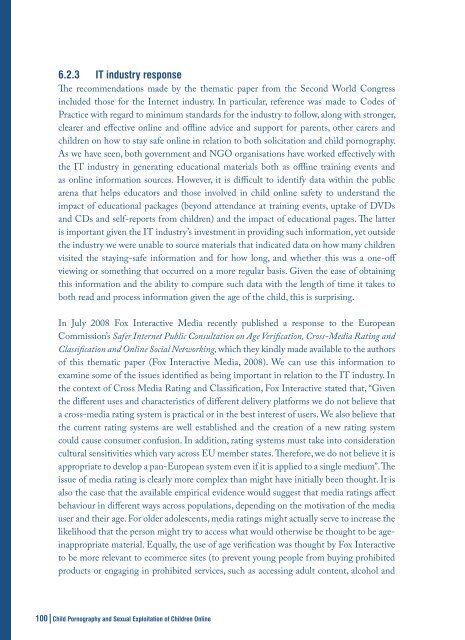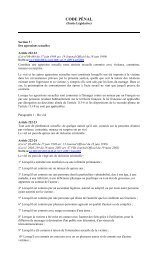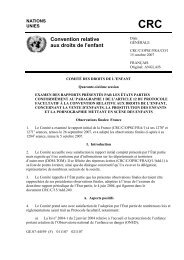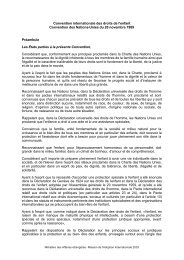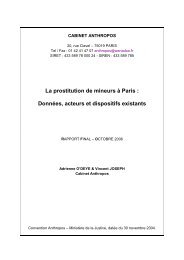child pornography and sexual exploitation of children online
child pornography and sexual exploitation of children online
child pornography and sexual exploitation of children online
You also want an ePaper? Increase the reach of your titles
YUMPU automatically turns print PDFs into web optimized ePapers that Google loves.
6.2.3 IT industry response<br />
The recommendations made by the thematic paper from the Second World Congress<br />
included those for the Internet industry. In particular, reference was made to Codes <strong>of</strong><br />
Practice with regard to minimum st<strong>and</strong>ards for the industry to follow, along with stronger,<br />
clearer <strong>and</strong> effective <strong>online</strong> <strong>and</strong> <strong>of</strong>fline advice <strong>and</strong> support for parents, other carers <strong>and</strong><br />
<strong>child</strong>ren on how to stay safe <strong>online</strong> in relation to both solicitation <strong>and</strong> <strong>child</strong> <strong>pornography</strong>.<br />
As we have seen, both government <strong>and</strong> NGO organisations have worked effectively with<br />
the IT industry in generating educational materials both as <strong>of</strong>fline training events <strong>and</strong><br />
as <strong>online</strong> information sources. However, it is difficult to identify data within the public<br />
arena that helps educators <strong>and</strong> those involved in <strong>child</strong> <strong>online</strong> safety to underst<strong>and</strong> the<br />
impact <strong>of</strong> educational packages (beyond attendance at training events, uptake <strong>of</strong> DVDs<br />
<strong>and</strong> CDs <strong>and</strong> self-reports from <strong>child</strong>ren) <strong>and</strong> the impact <strong>of</strong> educational pages. The latter<br />
is important given the IT industry’s investment in providing such information, yet outside<br />
the industry we were unable to source materials that indicated data on how many <strong>child</strong>ren<br />
visited the staying-safe information <strong>and</strong> for how long, <strong>and</strong> whether this was a one-<strong>of</strong>f<br />
viewing or something that occurred on a more regular basis. Given the ease <strong>of</strong> obtaining<br />
this information <strong>and</strong> the ability to compare such data with the length <strong>of</strong> time it takes to<br />
both read <strong>and</strong> process information given the age <strong>of</strong> the <strong>child</strong>, this is surprising.<br />
In July 2008 Fox Interactive Media recently published a response to the European<br />
Commission’s Safer Internet Public Consultation on Age Verification, Cross-Media Rating <strong>and</strong><br />
Classification <strong>and</strong> Online Social Networking, which they kindly made available to the authors<br />
<strong>of</strong> this thematic paper (Fox Interactive Media, 2008). We can use this information to<br />
examine some <strong>of</strong> the issues identified as being important in relation to the IT industry. In<br />
the context <strong>of</strong> Cross Media Rating <strong>and</strong> Classification, Fox Interactive stated that, “Given<br />
the different uses <strong>and</strong> characteristics <strong>of</strong> different delivery platforms we do not believe that<br />
a cross-media rating system is practical or in the best interest <strong>of</strong> users. We also believe that<br />
the current rating systems are well established <strong>and</strong> the creation <strong>of</strong> a new rating system<br />
could cause consumer confusion. In addition, rating systems must take into consideration<br />
cultural sensitivities which vary across EU member states. Therefore, we do not believe it is<br />
appropriate to develop a pan-European system even if it is applied to a single medium”. The<br />
issue <strong>of</strong> media rating is clearly more complex than might have initially been thought. It is<br />
also the case that the available empirical evidence would suggest that media ratings affect<br />
behaviour in different ways across populations, depending on the motivation <strong>of</strong> the media<br />
user <strong>and</strong> their age. For older adolescents, media ratings might actually serve to increase the<br />
likelihood that the person might try to access what would otherwise be thought to be ageinappropriate<br />
material. Equally, the use <strong>of</strong> age verification was thought by Fox Interactive<br />
to be more relevant to ecommerce sites (to prevent young people from buying prohibited<br />
products or engaging in prohibited services, such as accessing adult content, alcohol <strong>and</strong><br />
100|Child Pornography <strong>and</strong> Sexual Exploitation <strong>of</strong> Children Online


